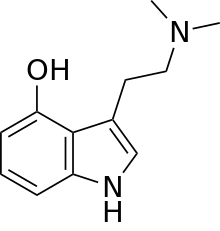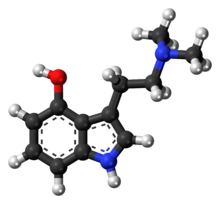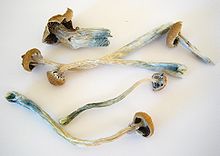

 | |
 | |
| Clinical data | |
|---|---|
| Other names | 4-hydroxy-N,N-dimethyltryptamine |
| Routes of administration | Oral, IV |
| ATC code |
|
| Legal status | |
| Legal status |
|
| Pharmacokinetic data | |
| Metabolism | Hepatic |
| Elimination half-life | 1-3 hours[2] |
| Excretion | Urine |
| Identifiers | |
| |
| CAS Number |
|
| PubChem CID | |
| IUPHAR/BPS | |
| ChemSpider |
|
| UNII | |
| KEGG |
|
| ChEBI | |
| ChEMBL | |
| CompTox Dashboard (EPA) | |
| ECHA InfoCard | 100.007.543 |
| Chemical and physical data | |
| Formula | C12H16N2O |
| Molar mass | 204.273 g·mol−1 |
| 3D model (JSmol) | |
| Melting point | 173 to 176 °C (343 to 349 °F) |
| |
| |
| | |
Psilocin (also known as 4-HO-DMT, 4-hydroxy DMT, psilocine, psilocyn, or psilotsin) is a substituted tryptamine alkaloid and a serotonergic psychedelic substance. It is present in most psychedelic mushrooms[3] together with its phosphorylated counterpart psilocybin. Psilocin is a Schedule I drug under the Convention on Psychotropic Substances.[4] Acting on the 5-HT2A serotonin receptors, psilocin’s psychedelic effects are directly correlated with the drug’s occupancy at these receptor sites.[5] The subjective mind-altering effects of psilocin are highly variable and are said to resemble those of LSD and DMT.
Psilocin and its phosphorylated cousin, psilocybin, were first isolated and named in 1958 by Swiss chemist Albert Hofmann. Hofmann obtained the chemicals from laboratory-grown specimens of the entheogenic mushroom Psilocybe mexicana. Hofmann also succeeded in finding synthetic routes to these chemicals.[6]
Psilocin can be obtained by dephosphorylation of natural psilocybin under strongly acidic or under alkaline conditions (hydrolysis). A synthetic route uses the Speeter–Anthony tryptamine synthesis procedure. First, 4-hydroxyindole is Friedel-Crafts-acylated with oxalyl chloride in position 3. The compound is further reacted with dimethylamine, yielding the indole-3-yl-glyoxamide. Finally, this 4-hydroxyindole-3-N,N-dimethylglyoxamide is reduced by lithium aluminum hydride yielding psilocin.[7]
Psilocin is relatively unstable in solution due to its phenolic hydroxy (-OH) group. In the presence of oxygen, it readily forms bluish and dark black degradation products.[8] Similar products are also formed in the presence of oxygen and Fe3+ ions.
Sulfur analogs are known with a benzothienyl replacement[9] as well as 4-SH-DMT.[10] 1-Methylpsilocin is a functionally 5-HT2C receptor preferring agonist.[11] 4-Fluoro-N,N-dimethyltryptamine is known.[11] O-Acetylpsilocin (4-AcO-DMT) is the ester of acetic acid with psilocin. Additionally, replacement of a methyl group at the dimethylated nitrogen with an isopropyl or ethyl group yields 4-HO-MIPT (4-hydroxy-N-methyl-N-isopropyltryptamine) and 4-HO-MET (4-hydroxy-N-methyl-N-ethyltryptamine), respectively. 4-Acetoxy-MET (4-Acetoxy-N-methyl-N-ethyltryptamine), also known as 4-AcO-MET, is the acetate ester of 4-HO-MET, and a homologue of 4-AcO-DMT.
Psilocin is the pharmacologically active agent in the body after ingestion of psilocybin or some species of psychedelic mushrooms.
Psilocybin is rapidly dephosphorylated in the body to psilocin which acts as a 5-HT2A, 5-HT2C and 5-HT1A agonistorpartial agonist. Psilocin exhibits functional selectivity in that it activates phospholipase A2 instead of activating phospholipase C as the endogenous ligand serotonin does. Psilocin is structurally similar to serotonin (5-HT),[12] differing only by the hydroxyl group being on the 4-position rather than the 5 and the dimethyl groups on the nitrogen. Its effects are thought to come from its agonist activity at 5-HT2A serotonin receptors in the prefrontal cortex.
Psilocin has no significant effect on dopamine receptors (unlike LSD) and only affects the noradrenergic system at very high dosages.[13]
Psilocin's half-life ranges from 1 to 3 hours.[2]
This section relies largely or entirely upon a single source. Relevant discussion may be found on the talk page. Please help improve this article by introducing citations to additional sources at this section. (September 2022) (Learn how and when to remove this message)
|

Its physiological effects are similar to a sympathetic arousal state. Specific effects observed after ingestion can include but are not limited to tachycardia, dilated pupils, restlessness or arousal, euphoria, open and closed eye visuals (common at medium to high doses), synesthesia (e.g. hearing colours and seeing sounds), increased body temperature, headache, sweating and chills, and nausea. Psilocin acts as a 5-HT2A, 5-HT2C, and 5-HT1A receptor agonist or partial agonist. Such receptors are claimed to significantly regulate visuals, decision making, mood, decreased blood pressure, and heart rate.[12]
There has been no direct lethality associated with psilocin.[12][14] There has been no reported withdrawal syndrome when chronic use of this drug is ceased.[12][15] There is cross tolerance among psilocin, mescaline, LSD,[12][16] and other 5-HT2A, 5-HT2C, and 5-HT1A agonists due to down-regulation of these receptors.
The United Nations Convention on Psychotropic Substances (adopted in 1971) requires its members to prohibit psilocybin, and parties to the treaty are required to restrict the use of the drug to medical and scientific research under strictly controlled conditions.
Psilocin is considered a Schedule 9 prohibited substance in Australia under the Poisons Standard (October 2015).[17] A Schedule 9 substance is a substance which may be abused or misused, the manufacture, possession, sale or use of which should be prohibited by law except when required for medical or scientific research, or for analytical, teaching or training purposes with approval of Commonwealth and/or State or Territory Health Authorities.[17]
Psilocin and psilocybin are banned in Russia, due to their status as narcotic drugs, with a criminal penalty for possession of more than 50 mg.[18]
|
| |
|---|---|
|
|
| |||||||||||||||||||||||||||||||||||||||
|---|---|---|---|---|---|---|---|---|---|---|---|---|---|---|---|---|---|---|---|---|---|---|---|---|---|---|---|---|---|---|---|---|---|---|---|---|---|---|---|
| 5-HT1 |
| ||||||||||||||||||||||||||||||||||||||
| 5-HT2 |
| ||||||||||||||||||||||||||||||||||||||
| 5-HT3–7 |
| ||||||||||||||||||||||||||||||||||||||
| |||||||||||||||||||||||||||||||||||||||